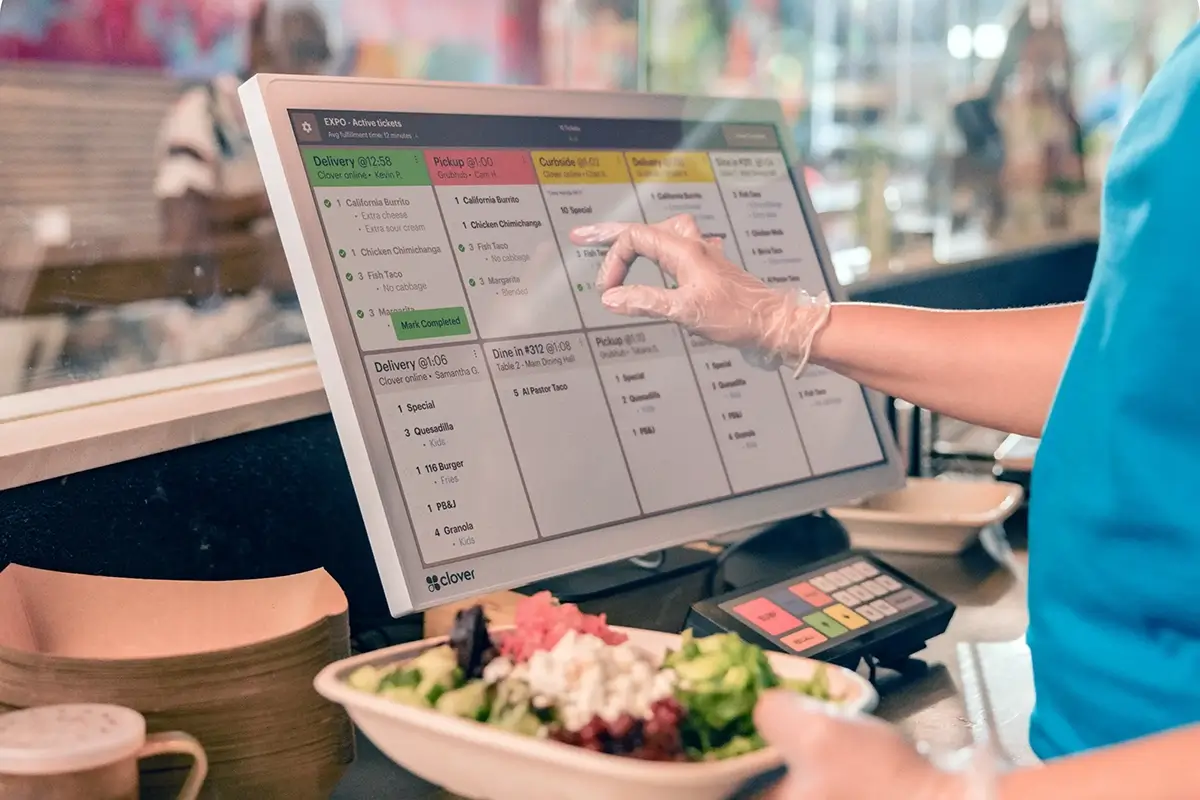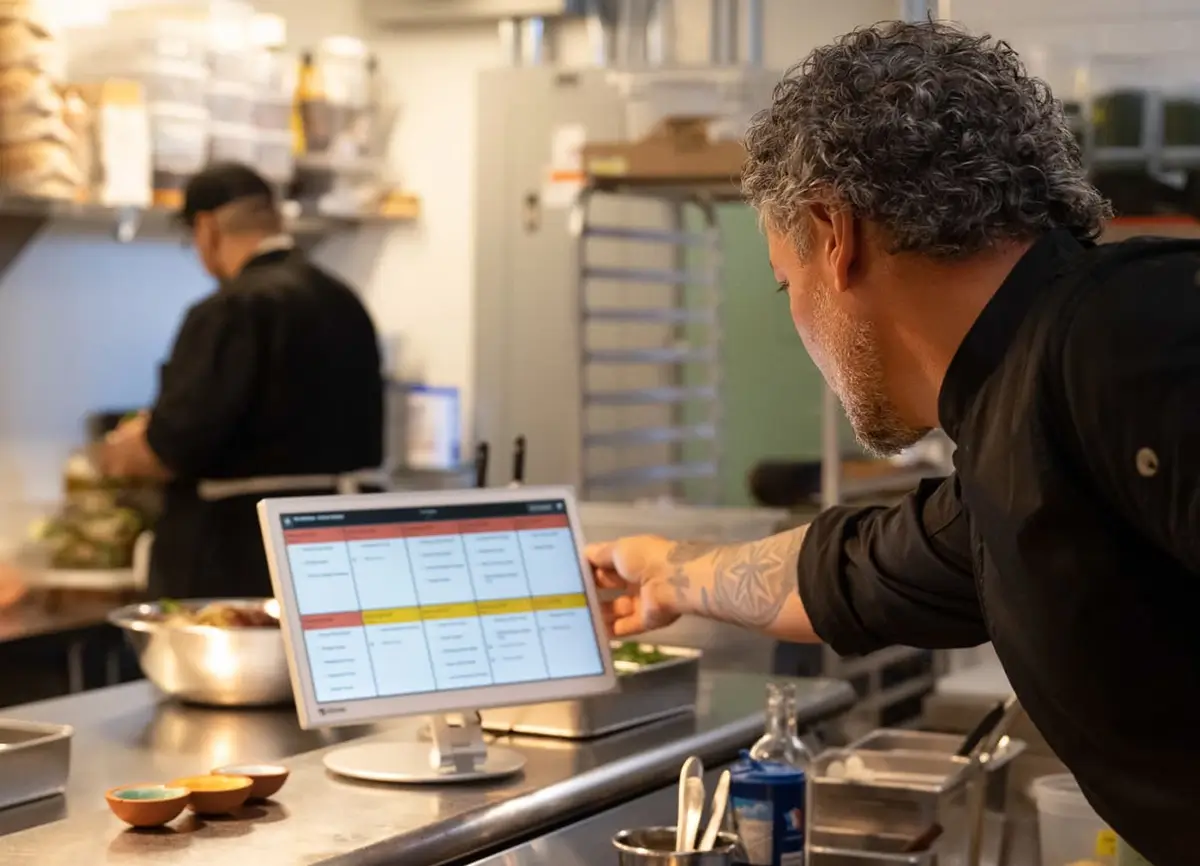The Essential Role of Kitchen Display Screens for Efficient Back-of-House Operations

In today’s fast-paced restaurant industry, efficient back-of-house operations are essential for success. One tool that is playing a crucial role in streamlining operations is the kitchen display screen (KDS). With its intuitive interface and powerful functionality, the KDS has become an invaluable asset for restaurant owners and kitchen staff alike.
By replacing traditional paper tickets, the KDS eliminates the potential for misplaced or lost orders. It allows for real-time communication between the front and back of house, ensuring that orders are received and prepared accurately and efficiently. With customizable settings, staff can prioritize orders based on their urgency, minimizing wait times and improving customer satisfaction.
Beyond order management, the KDS offers additional features that enhance kitchen operations. It provides detailed analytics and reporting, allowing managers to identify bottlenecks, optimize workflow, and make data-driven decisions. Integration with inventory management systems ensures that ingredient levels are constantly monitored and orders are placed in a timely manner, preventing stockouts and reducing waste.
In conclusion, kitchen display screens are revolutionizing back-of-house operations in the restaurant industry. Their ability to improve order accuracy, streamline communication, and enhance overall efficiency makes them an indispensable tool for modern kitchens.
Streamlining kitchen operations with display screens
Kitchen display screens streamline operations by simplifying order management and communication in the kitchen. With a user-friendly interface, KDS allows kitchen staff to easily view and track incoming orders in real-time. The elimination of paper tickets reduces the risk of errors and misplaced orders. Instead, orders are displayed on the screen, providing clear instructions and reducing the chances of misinterpretation.
The intuitive design of KDS enables staff to prioritize orders based on urgency, ensuring that high-priority orders are promptly attended to. This prioritization feature minimizes wait times and improves overall customer satisfaction. Additionally, KDS can be customized to display specific information, such as order modifications or special requests, ensuring that the kitchen staff has all the necessary details at their fingertips.
By streamlining order management and communication, KDS optimizes workflow and reduces the chaos often associated with busy kitchens. The clear visibility of orders and their status allows for efficient organization and coordination among kitchen staff, ultimately leading to faster order preparation and improved efficiency.

Improving communication and order accuracy
One of the key advantages of using kitchen display screens is the improvement in communication between the front and back of house. With traditional paper tickets, miscommunication and errors can easily occur, leading to delays and customer dissatisfaction. KDS eliminates these issues by providing real-time communication and accurate order information.
When a server enters an order into the POS system, it is immediately displayed on the KDS in the kitchen. This instant transmission of information ensures that the kitchen staff is aware of new orders as soon as they are placed. Any modifications or special requests are also clearly displayed, reducing the chances of miscommunication or missed instructions.
Furthermore, KDS allows for seamless communication between different kitchen stations. For example, if a dish requires multiple components prepared by different stations, the KDS can display the specific tasks and timing required for each station. This synchronized communication enhances coordination among staff, resulting in faster preparation and improved order accuracy.
With improved communication and order accuracy, restaurants can reduce errors, minimize wait times, and enhance customer satisfaction. The clear visibility of orders and their status ensures that each order is prepared correctly and delivered to the customer in a timely manner.
Enhancing efficiency and productivity in the kitchen
Kitchen display screens play a vital role in enhancing overall efficiency and productivity in the back of the house. By streamlining order management and communication, KDS reduces the time and effort required for manual tasks, allowing kitchen staff to focus on preparing and delivering orders.
The intuitive interface of KDS eliminates the need for manual order transcription, as orders are directly transmitted from the POS system to the display screen. This eliminates potential errors and saves valuable time that would otherwise be spent on writing and deciphering paper tickets. The reduction in manual tasks allows kitchen staff to work more efficiently, resulting in faster order preparation and improved productivity.
Moreover, KDS provides real-time updates on order status, allowing staff to prioritize and manage their tasks effectively. The clear visibility of orders and their preparation times enables staff to plan their workflow accordingly, reducing idle time and ensuring a smooth and continuous operation in the kitchen. This improved efficiency not only reduces wait times for customers but also enables the kitchen to handle higher volumes of orders without sacrificing quality.
With enhanced efficiency and productivity, restaurants can optimize their operations, increase throughput, and ultimately improve their bottom line.
Integrating kitchen display screens with other systems
Kitchen display screens can be seamlessly integrated with other systems, enhancing their functionality and effectiveness in back-of-house operations. One crucial integration is with the POS system, which allows for real-time order transmission from the front of house to the kitchen. This integration eliminates the need for manual order entry, reducing the chances of errors and streamlining the entire order management process.
Another important integration is with inventory management systems. By connecting the KDS to the inventory management system, the kitchen staff can monitor ingredient levels in real-time. This ensures that necessary ingredients are always available, preventing stockouts and reducing waste. When ingredient levels reach a predefined threshold, the KDS can automatically trigger an order, ensuring that supplies are replenished in a timely manner.
Furthermore, integrating KDS with customer relationship management (CRM) systems can provide valuable insights into customer preferences and order history. This information can be used to personalize the dining experience, offer targeted promotions, and enhance customer loyalty. By leveraging the data captured through the integration, restaurants can make informed decisions to improve customer satisfaction and drive repeat business.
The integration of kitchen display screens with other systems enhances their functionality and effectiveness, enabling restaurants to leverage technology for improved operations and customer experiences.
Customization and flexibility of kitchen display screens
Kitchen display screens offer a high degree of customization and flexibility to meet the unique needs of each restaurant. From the layout and design of the display to the specific information displayed, KDS can be tailored to suit the preferences and workflows of the kitchen staff.
The layout and design of the display can be customized to match the kitchen’s physical layout and the staff’s preferences. For example, screens can be mounted in various locations within the kitchen, such as above cooking stations or near food preparation areas. By placing the displays strategically, staff can easily view and access the information without interrupting their workflow.
Additionally, KDS allows for the customization of information displayed for each order. This customization can include specific instructions, modifications, or special requests from customers. By displaying this information prominently, kitchen staff can ensure that all orders are prepared accurately and meet the customer’s expectations.
Moreover, KDS can be configured to display different colors or icons to indicate the urgency or priority of each order. This visual cue allows staff to quickly identify high-priority orders and allocate their resources accordingly, minimizing wait times and improving overall efficiency.
The customization and flexibility offered by kitchen display screens empower restaurants to optimize their workflow, adapt to changing needs, and deliver a seamless dining experience to their customers.
Training and onboarding staff for kitchen display screen usage
To fully harness the benefits of kitchen display screens, proper training and onboarding of staff are essential. The intuitive interface of KDS makes it relatively easy for staff to learn and adapt to the new system. However, providing comprehensive training ensures that staff can utilize all the features and functionalities effectively.
During the training process, staff should be familiarized with the layout and functionality of the KDS. This includes understanding how to view and track orders, prioritize tasks, and communicate with other kitchen stations. Hands-on training, with real-world scenarios and examples, can help staff develop the necessary skills and confidence to use the system efficiently.
Furthermore, staff should be trained on how to troubleshoot common issues or errors that may arise while using the KDS. This includes understanding how to handle technical glitches, resolve connectivity issues, and ensure the smooth operation of the system. By providing staff with the necessary troubleshooting skills, restaurants can minimize downtime and ensure uninterrupted operations.
Ongoing training and support are also important to keep staff updated with any system updates or new features. This ensures that staff can fully leverage the capabilities of the KDS and continue to improve their efficiency in the kitchen.
By investing in proper training and onboarding, restaurants can ensure a smooth transition to using kitchen display screens and maximize the benefits they bring to back-of-house operations.
Conclusion and future trends in kitchen display screen technology
In conclusion, kitchen display screens have become an essential tool for efficient back-of-house operations in the restaurant industry. Their ability to improve order accuracy, streamline communication, and enhance overall efficiency makes them an indispensable asset for modern kitchens. By replacing traditional paper tickets, KDS eliminates errors and miscommunication, ensuring that orders are received and prepared accurately and efficiently.
Furthermore, KDS offers additional features that enhance kitchen operations, such as detailed analytics and reporting, integration with inventory management systems, and customization options. These features enable managers to optimize workflow, reduce waste, and make data-driven decisions. The seamless integration of KDS with other systems, such as POS and inventory management, further enhances their functionality and effectiveness.
As technology continues to evolve, we can expect future trends in kitchen display screen technology to further enhance back-of-house operations. Advancements in artificial intelligence and machine learning may enable KDS to automatically predict order volumes and adjust workflows accordingly. Integration with voice recognition technology may allow kitchen staff to communicate with the KDS hands-free, further improving efficiency and reducing errors.
Overall, the essential role of kitchen display screens in efficient back-of-house operations is undeniable. Their ability to streamline order management, improve communication, and enhance overall efficiency makes them a valuable investment for restaurants looking to optimize their operations and deliver exceptional dining experiences to their customers.


